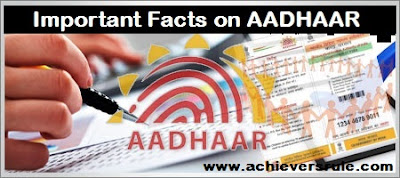Important Facts on AADHAAR
Introduction:
First of all we need to know what is UIDAI? It is 'Unique Identification
Authority of India ', a Central Government Agency in New Delhi which has the issuing authority of Aadhar Unique Identification Numbers(UID's) and Aadhar Cards. The Unique Identification Project was initially conceived by then
Planning Commission as an initiative that would provide a clear and unique
identification number (i.e. AADHAAR number) for each resident
across the country and that would be used primarily as the basis of efficient
delivery of welfare services.
Description of UIDAI:- Full form of UIDAI - Unique Identification Authority of India
- UIDAI is a nodal statutory organization
- Launched - 28th January, 2009
- Headquarters - New Delhi
- First Chairperson - Shri Nandan Nilekani ( Former Infosys CEO) on 2nd July, 2009
- First Director General - Shri Ram Sevak Sharma (IAS) in July 2009
- Chief Executive Officer (CEO) - Dr. Ajoy Bhusan Pandey (IAS)
- Part-time Member - Shri Rajesh Jain(Founder & Managing Director of net CORE Solution) and Dr. Anand Deshpande (Founder, Chairman & Managing Director of Persistent Systems)
- Chairman - Shri J. Satyanarayana (IAS) as part-time
- Data Centers - Industrial Model Township (IMT) Manesar (Gurgaon) in Haryana state and Hebbel (Bangaluru) in Karnataka.
The Unique Identification Authority of India (UIDAI) was set up by the
Government of India in January 2009, as an attached office under dash of
Planning Commission vide it is gazette notification. The UIDAI is mandated to
assign a 12-digit Identification (UID) number (termed as AADHAAR)
to all the residents of India. As per the notification, the UIDAI has been
given the responsibility to lay down the plan and policies to implement the
UIDAI scheme.
Much before the creation of the UIDAI efforts were
undertaken by Government of India to provide an identity to residents first in
1993, with photo-identity cards by the Election Commission and Further in 2003
with the approval of Multipurpose National Identity Card (MNIC).
The Government of India in a notification dated 16th December,
2010 recognizes the letter issued by Unique Identification Authority of India
(UIDAI) with details of name, address and Aadhaar number as an officially valid
document. Any Aadhaar holder or service
provider can verify an Aadhaar number for its genuineness through a
user-friendly service of UIDAI called Aadhaar
Verification Service (AVS).
Prospect of UIDAI:
To empower residents of India with a unique identity and a digital
platform to authenticate anytime, anywhere.
AADHAAR Timeline:
1999
|
After
Kargil war, Kargil Review Committee, headed by security analyst K.
Subrahmanyam. He was formed to study the state of national
security.
|
2000
|
A
report with the proposal and recommendations for citizens in village in
border region issued an identity card on7th January, 2000. The report was
submitted to our former prime minister Atal Bihari Vajpayee.
|
2001
|
A group
of ministers (GOM) headed by L.K Adbani submitted the report (the report said
the “Multi-purpose National Identity Card” project) in May 2001. The Ministry
of External Affairs proposed that a mandatory national identity card be
issued in late September, 2001.
|
2003
|
The
citizenship amendment bill, 2003 was introduced in the Lok Sabha by L.K
Adbani in December, 2003. The central Government resister every citizen of
India and issue the national identity card.
|
2009
|
In 28th January,
2009 UIDAI established and 23rd June, 2009 Nandan Nilekani
was appointed the chairman of UIDAI and cabinet minister by government to
head the project.
|
2010
|
In
April 2010 the logo and the brand name AADHAAR was launched by Nandan
Nilekani. In May 2010 Nandan Nilekani would support a legislation to protect
the data held by UIDAI and in July 2010 UIAI published a list of 15 agencies
to provide training to enrollment the process.
|
2012
|
UIDAI
launched an online verification system for aadhaar number on 7th February,
2012. On 26 November 2012, Prime Minister Manmohan Singh launched an Aadhaar-linked
direct benefit transfer scheme.
|
2013
|
On 1 January 2013 The project was to be introduced in 51 districts and
then slowly expanded to cover all of India. The Supreme Court issued an interim order on 23 September 2013.
|
2014
|
In March 2014, Nandan Nilekani resigned as the
Chairman. The former UIDAI Chairman Nandan Nilekani met with the Prime
Minister Narendra Modi and Finance Minister Arun Jaitley to convince them of
the project’s merits On 1 July, 2014.
|
2015
|
In March 2015 the Aadhaar-linked DigiLocker
service was launched. On 18th June, 2015 in a high level review meeting on
the progress of the UID project and DBT scheme.
|
2016
|
The Aadhaar (Targeted Delivery of Financial
and Other Subsidies, Benefits and Services) Bill, 2016 was passed in the
Lok Sabha on 11 March. In 31 March 2016, 99.9 crores (999
million) Aadhaar numbers have been issued in the project.
|
Advantages of Aadhaar
Cards:
- Aadhaar based Direct Benefit Transfer (LPG subsidy)
- Passport in 10days
- Voter Card linking
- Jan Dhan Yojana
- Digital Locker (Digilocker is a key initiative under Digital India)
- Provident Fund
- Monthly Pension
- Digital Life Certificate
- Opening new bank account
- Securities and Exchange board of India (SEBI)











Post a Comment